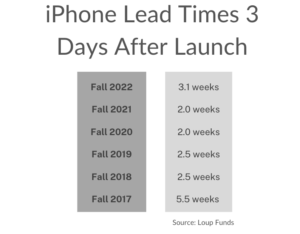While connecting lead times to demand is more of an art than a science, we’ve found that an expansion or compression of delivery times over the years have been a leading indicator of demand. Three days into the iPhone 14 cycle, we looked at average lead times in eight countries for the base iPhone 14, Pro, and Pro Max models and found an average lead time of 3.1 weeks. This is a longer average than we observed in 2021 and 2020 (measured as 2.0 weeks) as well as the cycles of 2018 and 2019 (measured as 2.5 weeks).
Digging into the lead times
The 3.1-week average is the highest since the 5.5-week average in Fall 2017 preceding iPhone revenue growth of +18% in FY18. The following year, we observed iPhone lead times compress to 2.5 weeks which kicked off a year where iPhone revenue declined by -14%. This suggests that the change in lead time is more important than actual weeks of lead time. It’s worth noting that some of that decline in FY19 was attributed to timing of initial iPhone shipments. Adjusting for this timing dynamic, we believe that iPhone revenue would have been down slightly in FY19 compared to the +18% growth in FY18.
The chart below outlines the average iPhone lead time for iPhone 14, Pro and Pro Max models three days after launch:


Methodology
We checked iPhone 14, Pro, and Pro Max lead times in 8 countries on Monday, September 19. Extrapolating lead times to sales is more of an art than a science given that we don’t know how many phones Apple is able to produce. That said, longer lead times have historically been an indicator of healthy demand and shorter lead times an indicator of softer demand.
Takeaways
- For September: We caution that we are only a few days into the cycle. Lead times suggest the iPhone segment for the September quarter is on track to report a slight upside to the Street.
- For FY23: If the trend continues, we expect an inline to slight upside to the Street’s +2.5% iPhone growth estimate for FY23.
- Reasons for strength: We believe the reason for the strength in sales is less about the new features on the iPhone 14 and more about a base of nearly 1.1B iPhones (Source: Loup) that need to be upgraded every 3-4 years.
Watch/Watch Ultra
We also observed that Watch lead times were slightly longer than last year. Series 8 is running just under 3 weeks, in line with our Series 7 lead time observations last year. We saw slightly longer Ultra lead times at just over 4 weeks which results in an uptick in the overall Watch lead times. Translating that lead time dynamic into sales should factor the macro headwinds on the Wearables business. Specifically, this Summer, demand for Watch softened as evidenced by the decline in sales by around -15% in the June quarter (Source: Loup). With the addition of Ultra, we expect Wearables growth to improve from the recent June quarter to flat in the December quarter.
